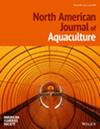Innovative structure to mount demand feeders to concrete raceways at a production fish hatchery
IF 1.3
4区 农林科学
Q3 FISHERIES
引用次数: 0
Abstract
ObjectiveAs a type of automatic feeder, demand feeders reduce labor costs and can improve fish‐rearing efficiencies. However, mounting demand feeders can be problematic because of the variety of nonstandardized fish‐rearing units. This article describes an innovative, simple, sturdy, and durable demand feeder mount for rectangular, concrete raceways.MethodsThe feeder mount was made from aluminum and sits flat on a raceway wall or walkway. A horizontal base plate, secured to the wall by vertical plates, holds a vertical riser of aluminum tubing. Attached to this tubing is a rod that secures the demand feeder.ResultThis feeder mount design has proven durable over several years of actual use. Over this time, it has needed no maintenance other than occasional cleaning with water to remove spilled fish food. The feeder can be easily and quickly removed from the mount by simply pulling a pin and sliding the feeder off of the tubing. The mount is constructed to dramatically reduce tripping hazards and occupational safety and health risks.ConclusionThis simple, inexpensive (~US$50 to construct), and no‐maintenance mount is a viable solution to the typically difficult problem of mounting demand feeders to concrete raceways used for trout production.在生产鱼类孵化场的混凝土滚道上安装喂食器的创新结构
目标 作为自动喂食器的一种,按需喂食器可降低劳动力成本,提高养鱼效率。然而,由于鱼类饲养装置的非标准化种类繁多,安装投喂器时可能会遇到困难。本文介绍了一种创新、简单、坚固、耐用的按需喂食器安装装置,适用于矩形混凝土走道。方法喂食器安装装置由铝制成,平放在走道墙壁或走道上。水平底板通过垂直板固定在墙壁上,并支撑着铝管的垂直立管。结果经过几年的实际使用,证明了这种进纸器支架设计经久耐用。在此期间,除了偶尔用水清洗一下溢出的鱼食外,无需进行任何维护。只需拔出一个销钉,将喂食器从管子上滑下,就可以方便快捷地将喂食器从支架上卸下。该支架的构造大大降低了绊倒危险和职业安全与健康风险。结论这种简单、廉价(建造成本约为 50 美元)且无需维护的支架是一种可行的解决方案,可以解决在用于鳟鱼生产的混凝土滚道上安装喂食器这一典型的难题。
本文章由计算机程序翻译,如有差异,请以英文原文为准。
求助全文
约1分钟内获得全文
求助全文
来源期刊
CiteScore
2.50
自引率
0.00%
发文量
46
审稿时长
18-36 weeks
期刊介绍:
The North American Journal of Aquaculture publishes papers on new research and practical experience in all areas of intensive and extensive fish culture. Topics include broodstock selection and spawning, nutrition and feeding, health and water quality, facilities and production technology, and the management of ponds, pens, and raceways.
The journal will consider papers dealing with ways to improve the husbandry of any aquatic species—marine or freshwater, vertebrate or invertebrate—raised for commercial, scientific, recreational, enhancement, or restoration purposes that may be of interest to practitioners in North America. Its scope includes both basic and applied science, but applied scientific endeavors—including practical experiences, descriptive studies, and other nontraditional, but pertinent works—are emphasized.

 求助内容:
求助内容: 应助结果提醒方式:
应助结果提醒方式:


